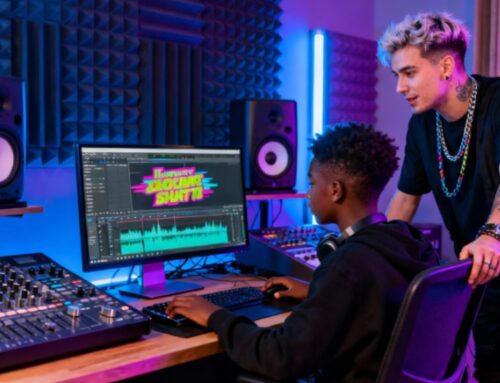For many musicians—whether they’re beginners, teens joining a group program, or adults returning to music—the dream of playing on stage is a big part of why they pick up an instrument. Performing live is an exciting milestone, but it also requires preparation, teamwork, and confidence. The weeks leading up to a show can be just as important as the performance itself. Bands that rehearse effectively, communicate well, and understand the flow of a live set tend to sound sharper, feel more connected, and enjoy the moment far more.
Live performance isn’t just about playing songs correctly. It’s about bringing energy to the stage, working as a unit, and managing all the details that help a show run smoothly—from sound checks to transitions to stage presence. Whether you’re in a youth rock program, practicing with friends, or joining a structured group band class, these core tips will help you get ready.
Did you know? The Rock Shop group program gives musicians in Burlington and Halton Region a real band experience—weekly rehearsals, professional coaching, and end-of-session live performances. Summer and March Break sessions available!
Start With a Strong, Rehearsable Set List
A great set begins long before the stage. Choose songs that fit your band’s strengths—vocals, instruments, and energy level. For younger or newer musicians, start with pieces that are achievable rather than overly complex. Confidence grows quickly when songs feel within reach.
Most coaches recommend:
-
A mix of familiar and fresh songs
-
Varied tempos (one fast, one mid, one slower)
-
Music that showcases each member
-
Songs everyone genuinely enjoys
Bands tend to rehearse more effectively when they’re excited about their set list. If a song feels frustrating or consistently breaks momentum, consider swapping it out.
Rehearse Transitions, Not Just Songs
One of the biggest differences between practice-room musicians and polished live performers is how well they handle transitions. Audiences notice how you enter, exit, and move from song to song just as much as they hear the music.
During rehearsals, decide:
-
Who counts in each song
-
Whether the band speaks between songs
-
What order members tune in
-
How long each transition should be
-
Which member announces the band or addresses the audience
These details help momentum flow smoothly and keep the band sounding tight.
Master Stage Presence and Movement
Even newer musicians can develop a strong stage presence with simple habits. Confidence is partly musical skill—but also posture, expression, and how you carry yourself.
Some reliable tips include:
-
Keep your eyes up (not on the floor)
-
Acknowledge the crowd occasionally
-
Stand tall and grounded
-
Move with the beat when appropriate
-
Avoid looking overly tense between sections
Beginners often find it helpful to rehearse with microphones, stage monitors, and performance lighting if possible. Practicing stage presence ahead of time prevents nerves from taking over on the big day.
Know Your Equipment—and Have Backups
Equipment issues are one of the most common challenges for new performers. A small snag like a loose cable or broken drumstick can interrupt the flow of a whole set.
Before show day, make sure you:
-
Label cables and know what each connects to
-
Tune instruments thoroughly
-
Replace weak strings or worn drumsticks
-
Test your amp settings
-
Pack spare picks, strings, patch cables, batteries
-
Bring water and a small towel
Many coaches recommend a quick gear checklist taped inside the instrument case so nothing is forgotten.
Use a Practice-Room Sound Check System
Live sound checks can be chaotic, especially when multiple bands share a stage. To prepare, build a simple routine during rehearsals that mimics a sound check:
-
Drums set baseline volume
-
Bass locks in with the drums
-
Guitars and keys adjust level
-
Vocals come last
-
Short playthrough of a verse or chorus
Practicing this order helps the whole band move efficiently on stage and gives the sound tech a clear signal to balance levels.
Record Your Rehearsals for Honest Feedback
Recording practices—even on a phone—gives instant clarity on what needs improvement. Musicians often catch timing issues, dynamics problems, or vocal inconsistencies immediately once they listen back.
Reviewing recordings helps the band:
-
Tighten rhythm
-
Smooth out transitions
-
Balance volume
-
Work on harmonies
-
Improve confidence
It also helps members understand each other’s parts more clearly, making rehearsals smoother.
Practice “Show Flow” as a Full Run-Through
At least once or twice before show day, run the entire set without stopping—just like a real performance. This helps:
-
Build endurance
-
Identify weak spots
-
Rehearse transitions
-
Create confidence in the order of songs
-
Reduce stage nerves
It also reveals whether the set feels too long, too short, or too intense at certain moments.
Manage Nerves With Practical Strategies
Even experienced performers feel nervous before going on stage. Coaches often recommend:
-
Deep breathing before stepping up
-
Light stretching for tension
-
Positive visualization (imagining the show going well)
-
Staying hydrated
-
Keeping the atmosphere supportive
Nerves usually fade within the first 30 seconds of the first song. Preparation is the strongest antidote to anxiety.
Understand Live Sound Basics
Musicians perform better when they know how their sound reaches the audience. Even a basic understanding helps avoid confusion during setup.
Key concepts include:
-
What monitors do
-
How microphones pick up sound
-
Why feedback occurs
-
How amps interact with house PA systems
-
What a front-of-house mix is
The more informed the band is, the smoother the show runs.
Celebrate, Learn, and Build On the Experience
After the performance, take time to talk as a group about what went well and what could be improved. Celebrate the success—it’s a major accomplishment—and keep the momentum going by choosing new songs, setting new goals, or signing up for another season.
Live music builds confidence, teamwork, musicianship, and lifelong passion. Is joining a rock band in your future?






